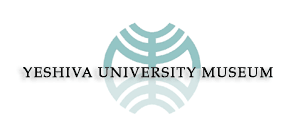
A
Brief History
Since
its founding in 1973, Yeshiva University Museum's changing exhibits have
celebrated the culturally diverse intellectual and artistic achievements
of over 3,000 years of Jewish experience. The Museum provides a window
into Jewish culture throughout the world and throughout history in its
acclaimed multi-disciplinary exhibitions and award-winning publications.
Renowned scholars and expert curators provide unique skills that weave
together art, artifact, and text to create innovative exhibits. These
comprehensive historical exhibitions reveal the panoramic landscape of
Jewish cultural life in communities the world over —
from Germany to Ethiopia, from Turkey to Morocco, from Birobidjan to Dubrovnik,
and from Israel to the United States. By educating audiences of all ages
with dynamic interpretations of Jewish life, past and present, along with
wide-ranging cultural offerings and programs, the Museum attracts young
and old, Jewish and non-Jewish audiences.
Exhibitions
Yeshiva University Museum presents exhibitions with an interdisciplinary
focus that reflect the diversity of the Museum's collection of more than
6,500 artifacts. "Our primary focus is the interpretation of Jewish
history from a multi-disciplinary perspective, and we produce two types
of exhibitions, usually shown concurrently," explains director Sylvia
A. Herskowitz. "One exhibit examines a Jewish community or historic
event; the other features emerging or established contemporary artists."
As a resource for scholarly research, Yeshiva University Museum's displays of contemporary Jewish art provide unique opportunities for artists, historians, collectors, and ethnographers to examine and compare objects, ideas, and techniques. These shows also provide the public with an exciting up-to-date survey of art currently being created by Jewish artists throughout the world. The Museum regularly draws on Yeshiva University's special expertise in many significant areas of Jewish history.
Collections
As a founding member of the Council of American Jewish Museums, Yeshiva
University Museum has taken a leading role to develop conservation and
preservation techniques for Jewish museums. The Museum collects and preserves
an incredible range of objects that reflect Jewish culture: ceremonial
objects, fine and folk art, textiles, rare books, manuscripts, photographs,
ethnographic material, and ephemera.
Highlights of the Museum's collection of over 6,500 objects include: an illuminated manuscript from 1478 recording the Simon of Trent blood libel trial; ritual objects and textiles; ceremonial and domestic textiles, clothing, and accessories from around the world; architectural models of historical synagogues, commissioned to mark the Museum's inaugural exhibition in 1973; Thomas Jefferson's 1818 letter affirming religious freedom and denouncing anti-Semitism; and paintings, graphics, sculpture, and early Twentieth century works of art by Israeli, European, and American artists
Programs
Yeshiva University Museum stimulates both the intellectual and creative
imagination of its broad audiences by presenting a vast array of public
programs, including craft workshops, lectures, concerts, and multi-lingual
exhibition tours in English, Spanish, Russian, Yiddish and other foreign
languages. Some programs are just for children, others are for adults
only, and many provide an opportunity for family fun. All of these events
are designed to inform and enhance the Jewish cultural connection.
Yeshiva University Museum's expert educational staff has developed nationally recognized outreach programs that include working with administrators and teachers in New York City public schools to provide young students with hands-on activities that supplement their school curricula. By undertaking an ongoing, year-round commitment to school-age children, the Museum addresses the needs of New York City's culturally diverse neighborhoods, as well as Jewish schools throughout the tri-state area. By hosting thousands of children annually from Jewish schools, private schools, and inner-city neighborhoods, the Museum continues to build bridges to the many different communities that are part of the American mosaic.